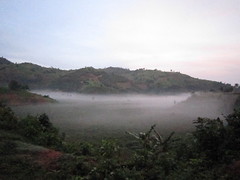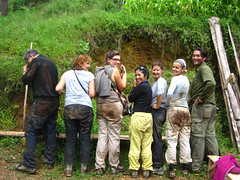Here’s a look back into my travel diaries: In 2012, I had the once-in-a-lifetime opportunity to visit the gorillas in Africa.
Table of Contents
I once saw a monkey – Gorilla Trekking in Uganda
I was not going to see the gorillas. I was not going to fork over the 500 USD to hike through the forest for a slim chance of disturbing apes in their nap. But my travel companion insisted: “‘Trust me on this one!”

So on May 18th, I board the Bismarckan overnight bus to the remote town of Kisoro, a few miles North of the fabled Virunga mountains. In my backpack: A slip of paper granting me one of eight spots in the group that would visit the Bwindi Nkuringo gorillas two days later.
We arrive in Kisoro at four in the morning. After a brief consideration, our tired limbs convince us to leave the safety of the bus and find beds in a guest house.
We leave the Virunga Hotel a few hours later to find a driver that will take us the final 25 or so km to Bwindi National Park, the Impenetrable Forest. There is no public transport. The guy that the Golden Monkey Guest House across the street recommends wins the bid thanks to the best price ($80) and the persuasive powers of the charming Golden Monkey owner, who vouches for the reliability of her driver.
With Bayern Munich and Chelsea battling out the Champions League final all the way to penalties, my night again is once again cut short. But in anticipation of the gorillas, I wouldn’t have slept a lot anyway. Before sunrise, we pack the lunch packs we had ordered at the city’s only coffee shop and get into the car.
 The rule says that if you aren’t at the park by eight the group will leave without you and your 500 USD will blow up in smoke. So we are a bit anxious. But the only accommodation available at the park – the Nkuringo Bwindi Gorilla Lodge – is about 100 USD per night – money we are not prepared to spend. While we drive along the serpentines, the fog slowly lifts and gives way to awe-inspiring views of the lake and the mountains.
The rule says that if you aren’t at the park by eight the group will leave without you and your 500 USD will blow up in smoke. So we are a bit anxious. But the only accommodation available at the park – the Nkuringo Bwindi Gorilla Lodge – is about 100 USD per night – money we are not prepared to spend. While we drive along the serpentines, the fog slowly lifts and gives way to awe-inspiring views of the lake and the mountains.
We reach Bwindi in time and meet our fellow wanderers. They are two American women and a French couple with their adult daughter.
Preparations for the gorilla trek
Before we head out the guide gives us an introduction to the gorilla trekking process:
- Early in the morning rangers have set out to find our group of gorillas, Nkuringo. They will inform our guide via radio about where to go until we manage to catch up.
- There are no paths in the park, which means going cross country – luckily, I have put on a long sleeve shirt and am wearing my trusty walking shoes.
- Our goal is to see the Nkuringo group and only the Nkuringo group. Should we come across another group, we will not be allowed to go anywhere near them as only a fraction of the more than 800 apes in the Impenetrable Forest is accustomed to humans.
- To protect us from unruly gorillas and forest elephants we will be joined by two armed guards.
- Once we are with the group we will not be allowed to go closer than 2m. However, should an animal come towards us we are allowed to stay put. And man, watch the video – did I stay put!
- Anyone with a fever or any other sign of a cold should step forward now. To protect the apes they will not be allowed to enter the park.
- Oh, and we might walk all day and never find the gorillas. In that case, the next walk we book would be 50% off. But that’s why we came here and not Virunga: there are no borders that would stop the rangers from finding our group and sighting is almost guaranteed.
We are handed walking sticks and encouraged to hire one of the porters waiting outside the office. They might not only prove useful for carrying our bags but help along the steep climbs. Only one of the Americans decides to pick up on the offer.
Gorilla Trekking – The real deal!
After less than half an hour, we turn off the narrow path onto a field clinging to the side of the mountain. This is more than just steep!
 The farmers greet us with broad smiles. They are wearing gumboots – just like the rangers – and are moving up and down the slope seemingly without effort while we on our walking sticks struggle and decide more than once to get down on all four or slide on our arses to avoid taking a dive.
The farmers greet us with broad smiles. They are wearing gumboots – just like the rangers – and are moving up and down the slope seemingly without effort while we on our walking sticks struggle and decide more than once to get down on all four or slide on our arses to avoid taking a dive.
It’s good, moist, reddish-brown soil. You understand why the farmers are skeptical about leaving such good soil to the National Park and the gorillas. Uganda’s population is exploding and farming space rare.
After another hour of slipping and sliding, we get to a group of trees. The guide bids us leave sticks and backpacks behind. We follow suit.
Suddenly, slightly above me to my left I see him lounging among the leaves: the male is watching us and is thoroughly unimpressed. After a few minutes, he gets bored, gets up and makes his way down the hill. He’s not walking, he’s rolling, and we hear him break through the undergrowth.
We follow carefully, doing our best to avoid rolling.
And then we’re right in the center of the group:
A baby is sleeping in a tree.
A young male is watching another playing.
We hear branches break around us, munching and occasional grunts.
The rest of the group is eating and resting in the trees around us.
We sit still and watch and listen. One of the babies starts putting on a show, climbing and swinging a liana. All the while, the older one is watching intently. The baby keeps coming up to me to touch my knee. He puts his finger in his mouth to taste what strange thing I might be. When he gets bolder and bolder, the guide asks me to retreat – who knows what germs I’m carrying…
Suddenly it’s over. One by one the group moves on. We stay behind.
As we crawl back up the mountain through the fields we learn that we’ve been lucky: We have met the group just outside the park and thereby saved ourselves a fair bit of hiking.
PS: For more photos, flick through my Flickr album about my visit to the gorillas (note, photos aren’t edited and have been taken on an old camera…)
Practical info & links to organize your visit to the gorillas
So would I do it again? Was it worth it?
With only a few hundred of these majestic animals remaining, in some of the least stable countries in the world (DRC, Rwanda, Uganda) seeing gorillas in their natural habitat is a once-in-a-lifetime experience. 500 USD is a lot of money. But if you know that Ugandans themselves also pay 250 USD and if you see the rangers’ struggle to secure the gorillas’ home it seems that this is money well spent.
- For the latest on Gorilla trekking permit prices and processes, check the Bwindi Impenetrable Forest National Park website. Currently, permits for foreigners are $450 off-season/$600 in-season.
- Since 2012, only few things have changed in Kisoro and Bwindi. However, there is now a backpackers’ lodge close to the forest, charging as little as $14/night: the Bwindi Backpackers Lodge
- If you’d rather book a tour through Uganda, check Get Your Guide. Note, that all prices quoted here are group prices – so, if you’re planning on Gorilla trekking with the whole family (make sure you inquire about the age limit) or a group of friends, this might turn out to be an economical solution.
PPS: This post was first published in May 2013, and updated in December 2017.